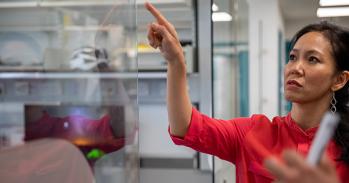
Cambridge scientists have discovered that cancer cells ‘hijack’ a process used by healthy cells to spread around the body, completely changing current ways of thinking around cancer metastasis.
Cambridge scientists have discovered that cancer cells ‘hijack’ a process used by healthy cells to spread around the body, completely changing current ways of thinking around cancer metastasis.
These findings are among the most important to have come out of my lab for three decades
Richard Gilbertson
The team based at the Cancer Research UK (CRUK) Cambridge Institute, University of Cambridge, found that blocking the activity of the NALCN protein in cells in mice with cancer triggers metastasis.
The research, which was published in Nature Genetics today, also discovered that this process is not just restricted to cancer. To their surprise, when they removed NALCN from mice without cancer, this caused their healthy cells to leave their original tissue and travel around the body where they joined other organs.
They found, for example, that healthy cells from the pancreas migrated to the kidney where they became healthy kidney cells. This suggests that metastasis isn’t an abnormal process limited to cancer as previously thought, but is a normal process used by healthy cells that has been exploited by cancers to migrate to other parts of the body to generate metastases.
Group Leader for the study and Director of the CRUK Cambridge Centre, Professor Richard Gilbertson, said: “These findings are among the most important to have come out of my lab for three decades. Not only have we identified one of the elusive drivers of metastasis, but we have also turned a commonly held understanding of this on its head, showing how cancer hijacks processes in healthy cells for its own gains. If validated through further research, this could have far-reaching implications for how we prevent cancer from spreading and allow us to manipulate this process to repair damaged organs.”
Despite being one of the main causes of death in cancer patients, metastasis has remained incredibly difficult to prevent, largely because researchers have found it hard to identify key drivers of this process that could be targeted by drugs. Now that they have identified NALCN’s role in metastasis, the team are looking into various ways to restore its function, including using existing drugs on the market.
Lead researcher on the study Dr Eric Rahrmann, said: “We are incredibly excited to have identified a single protein that regulates not only how cancer spreads through the body, independent of tumour growth, but also normal tissue cell shedding and repair. We are developing a clearer picture on the processes that govern how cancer cells spread. We can now consider whether there are likely existing drugs which could be repurposed to prevent this mechanism from triggering cancer spreading in patients.”
NALCN stands for sodium (Na+) leak channel, non-selective. Sodium leak channels are expressed predominately in the central nervous system but are also found throughout the rest of the body. These channels sit across the membranes of cells and control the amount of salt – that is, sodium – that goes in and out of the cell. Controlling this process also alters the balance of electricity across the cell membrane. It is not yet clear why these channels seem to be implicated so directly in cancer metastasis.
The research was funded by CRUK, whose Director of Research, Dr Catherine Elliott, said: “Once cancer has spread from the first tumour, it is harder to treat because we are looking at multiple sites in the body and working with new tumours that may be resistant to treatment. Discovering that a cancer has spread is always devastating news for patients and their families and so we are delighted to have supported this incredible research which may one day allow us to prevent metastasis and turn cancer into a much more survivable disease.”
Reference
Rahrmann, E P et al. The NALCN channel regulates metastasis and nonmalignant cell dissemination. Nat Genetics; 29 Sept 2022; DOI: 10.1038/s41588-022-01182-0
Adapted from a press release from Cancer Research UK

The text in this work is licensed under a Creative Commons Attribution 4.0 International License. Images, including our videos, are Copyright ©University of Cambridge and licensors/contributors as identified. All rights reserved. We make our image and video content available in a number of ways – as here, on our main website under its Terms and conditions, and on a range of channels including social media that permit your use and sharing of our content under their respective Terms.




